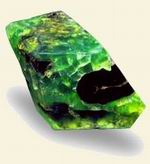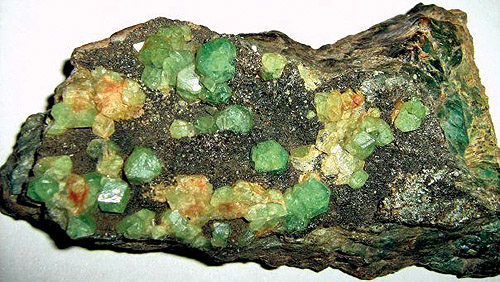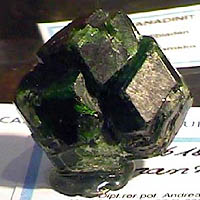DEMANTOID


 Characteristics of the mineral.
Characteristics of the mineral.
Another name for the rare and valuable Urals variety of chrysolite is demantoid (these are varieties of stone, green as a young grass, very bright and very bright). The word Demantoid can be translated as a diamond (German demant - diamond, Greek eidos - similar). Demantoid is a rare variety of transparent bright green pomegranates. Their coloration is caused by impurities of iron and chromium, yellow shades of demantoid are caused by titanium compounds.
Demantoids were discovered in the Urals in 1874 on the river Bobrovka. After the presentation of these stones at the Paris exhibition in 1893, a demantoid boom began in the world. And nowadays the price of jewelry with demantoid is quite high: one carat is usually estimated at a minimum of 100-600 dollars. Large stones are rare. The play of light on the faces of demantoids is determined by high refraction and recalls the king of precious stones - the diamond. Artificial lighting only enhances this optical effect. There are demantoids with the effect of a cat's eye, which create fibrous inclusions. There are stones with beautiful golden sparks. In addition to the territory of Russia (the Urals, Kamchatka), demantoids are found in Italy and Africa. Beautiful transparent crystals of demantoid found in Italy in the Ala Valley (Italian miners sometimes call them "seeds" of asbestos), in gold-bearing placers of Sri Lanka, Congo, Zaire, Switzerland, USA (Arizona). Demantoid was also found in Chukotka of the Russian Federation (CIS).

Demantoid. Tamvatney, Koryak Highlands, Chukotka, Russia (CIS). Photo: © V.S. Chernavtsev.

Demantoid (different andradita). Poldnevaya d., Wed. Ural, Russia. Photo: © А.А. Evseev.
The darker demantoid vveruh - unmodified, the lighter at the bottom - from the secondary
(Including river and alluvial) modified demantoid placers

Demantoid (different andradita), Madagascar. Modified (metamorphic). Photo: © А.А. Evseev.
 The hardness of the demantoid is 6.5-7 (this is the softest garnet, low hardness and brittleness of the stone somewhat reduce its value). Jewelers sometimes called it the Urals or Siberian chrysolite, the Urals or the Beaver emerald. In the late XIX - early XX century. Demantoid was one of the main exported from Russia jewelry stones. Demantoid is represented mainly by small rounded and oval grains ranging in size from a fraction of a millimeter to 10 mm, larger stones are extremely rare.
The hardness of the demantoid is 6.5-7 (this is the softest garnet, low hardness and brittleness of the stone somewhat reduce its value). Jewelers sometimes called it the Urals or Siberian chrysolite, the Urals or the Beaver emerald. In the late XIX - early XX century. Demantoid was one of the main exported from Russia jewelry stones. Demantoid is represented mainly by small rounded and oval grains ranging in size from a fraction of a millimeter to 10 mm, larger stones are extremely rare.
Demantoid - the most valuable gemstone jewelry group. It is believed that the demantoid are among the most attractive, expensive and valuable gems in a number of multi-colored garnets. In all these places, the demantoid is represented mainly by small, round and oval grains ranging in size from a fraction of a millimeter to 10 cm, larger stones are extremely rare.
The color of the demantoid is green with a yellowish, pistachio, emerald and brown hue. The brilliance is diamond. The shape of the cut is a diamond, which allows you to better identify his game, less often stepped. Stones with defects are processed in the form of cabochons. As a jewelry raw material, green and grass-green demantoid are used. Demantoid recommended to use for the manufacture of pendants and necklaces, since for rings it has a low hardness. Good stones go on sale in very small quantities, and the prices for them are constantly increasing.
When identifying the demantoid, it is most difficult to distinguish it from chrysolite, green zircon, rare earth synthetic garnets, small stones from the emerald. The diagnostic features of the demantoid include its optical isotropy, high dispersion, absorption lines, presence of inclusions of bisolite. The fibers of the bisolite are parallel to each other, diverge from one or several centers in the form of so-called "horse tailings" or form the "sun". A particularly important feature is the constant (in 99%) presence in the demantoid of inclusions of fibrous actinolite asbestos (bisolite).
Magic properties of stones.
Experts of the mystical properties of stones believe that the bright green color of precious demantoids contributes to a feeling of calm and peace. It is also well known that this color calms the nervous system.

Poisonous and radioactive dangerous stones and minerals
** - poisonous stones and minerals (mandatory check in the chemical laboratory + explicit indication of toxicity).
** - radioactive stones and minerals (mandatory check on the standard dosimeter + ban on open sales in the case of radioactivity over 24 milli / g / h + additional measures of population protection).
All rare stones are subject to mandatory inspection at the standard dosimeter for the permissible level of radiation and in the chemical laboratory for the absence of poisonous and evaporating components that are dangerous to humans and the environment.


Comments
Commenting on, remember that the content and tone of your message can hurt the feelings of real people, show respect and tolerance to your interlocutors even if you do not share their opinion, your behavior in the conditions of freedom of expression and anonymity provided by the Internet, changes Not only virtual, but also the real world. All comments are hidden from the index, spam is controlled.